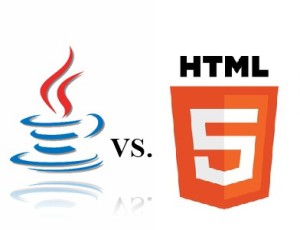 When you first start learning about Web programming, all the different languages and frameworks can be a little overwhelming, but one important distinction to understand is the difference between JavaScript and HTML. These terms describe programming languages that have different roles and purposes but that work together for creating Web pages and mobile apps.
When you first start learning about Web programming, all the different languages and frameworks can be a little overwhelming, but one important distinction to understand is the difference between JavaScript and HTML. These terms describe programming languages that have different roles and purposes but that work together for creating Web pages and mobile apps.
The Roles of HTML and JavaScript
HTML is a markup language that is simply used to define the visual elements of a Web page, while JavaScript is a general-purpose scripting language with many uses beyond Web programming. Their most common use is for programming website user interfaces, and each language has a different role in this task. HTML is used to tell the browser where all the text, images and visual elements are supposed to go, and websites can be programmed entirely in HTML without any JavaScript at all.
The earliest websites were built entirely from HTML code that simply told the browser where to display the page title, subheadings and text body, along with a few images in highly compressed GIF format. These old, static websites were popular in the 1990s when most people had dial-up Internet connections that maxed out at 56 Kbps. JavaScript wasn’t in common use at the time, because it wasn’t supported by browsers. There are even browsers today that don’t support JavaScript, because it is fairly resource-intensive. Lightweight browsers on the Linux platform allow older computers to search the Web by disabling JavaScript support. An old computer with less than 512MB of RAM can easily freeze when trying to load JavaScript-heavy sites, and beginning Web programmers sometimes embed ads with inefficient JavaScript code that takes a long time even for newer computers to load.
How HTML and JavaScript Work Together
JavaScript is actually a simple language to learn, but some fundamental programming knowledge is needed to make Websites efficient. JavaScript is used to make a Web interface dynamic, which means that the text and visual elements can change while the user interacts with the page. It usually requires more memory and processing power than HTML, because it is used to write more complicated programs. They can be executed on the user’s machine or on the website’s server, and there are various frameworks, such as AngularJS and Node.js, that make JavaScript programming easier and more efficient.
The difference between JavaScript and HTML is very large, but they work together quite seamlessly to integrate dynamic Web elements and page templates. JavaScript code can be inserted directly into an HTML file when only a few lines of scripting code are needed. When extensive scripting is needed, it’s better to put it all in separate files and reference it as necessary. HTML was invented by the creator of the World Wide Web, Tim Berners-Lee, who now heads the World Wide Web Consortium, according to Time. The most recent iteration of HTML is version 5, which adds support for 2-D animations, page transitions and multimedia content. JavaScript was invented by Firefox engineer Brandon Eich, and it has been officially adopted as the programming language of open-source HTML and Web applications.
Related Resource: ActionScript
Web programming is one of the most important skills to have in the digital age, and it’s one of the easier computer science skills to learn. Understanding the difference between JavaScript and HTML is a good first step in becoming a Web programmer.
 Follow
Follow
